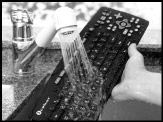NERDS WISTFUL FOR the pulse-pounding excitement of the PC era at its frenetic peak need only swap one letter—and now look to CE for their adrenaline fix. The degree to which consumer electronics, or CE, has inherited the innovation mantle from personal computers was apparent at this month’s international Consumer Electronics Show in Las Vegas. It’s not that consumer-electronics companies are spearheading dramatic new computing breakthroughs. But they are expert at doing something that PC companies, facing market penetration stalled at roughly 60 percent of U.S. households, can only dream of: taking complicated, cutting-edge technology and integrating it into everyday life.
Examples of that trend abounded at CES among the three-dozen Washington state companies sharing the packed show floor with nearly 2,300 exhibitors from 128 countries.
Take Seattle-based Icebox. Its Icebox CounterTop kitchen entertainment center, due in June, combines a 12-inch LCD touch screen, TV, DVD/CD player, FM radio, and Web browser (running on Microsoft Windows CE) into a die-cast metal base in a choice of white, black, or silver. It could be mistaken for a large retro blender with a swiveling monitor. The crowning consumer-electronics achievements are a magnetic stylus that adheres to a refrigerator, and a wireless keyboard and remote control that can be rinsed in the sink should they become inadvertent pasta plates. Buyers should hope the touch screen can take a stray champagne cork as gracefully.
The CounterTop (following in the footsteps of the Icebox FlipScreen under-cabinet model for custom installers) is under the corporate parentage of experienced home-appliance maker Salton. Though CounterTop will carry Salton’s Westinghouse brand, it probably won’t be found on the small electric appliances aisle at Bartell Drug: The anticipated price is between $1,800 and $2,100.
OTHER TECHNOLOGY companies are more interested in controlling the entire home over a wired or wireless network, another strong computing trend at CES. Lantronix, whose software-development office is in Redmond, unveiled Premise Home Control 2.0, an impressive consumer version of its home-automation software for professional installers. The computer application links everything from high-end audio, DVD, and TiVo components to sprinklers, lights, and X-10 video cameras without requiring arcane programming knowledge. Then it all can be controlled from a PC or a PDA in the home or across the Internet. But the software’s $299 price, when combined with the cost of network connectors for devices that don’t have them built in, might put it out of reach of Joe 486-pack.
EVEN WELL-KNOWN companies that traditionally look to the PC as their cash cow want to milk the high-tech CE boom. Microsoft grandly announced its Smart Personal Objects Technology (SPOT), which at first will let new wristwatches from Citizen and Fossil get news, weather, and sports from the Internet over the FM radio band this fall. Fawning press coverage conveniently neglected to note that Timex pioneered this category two years ago with the Timex Internet Messenger watch, using the more-broadly available paging network. Yet while Microsoft plays CE catch-up in the hopes that SPOT will bark up the right tree, its marketing muscle may legitimize others’ earlier efforts.
Of course, the encroachment of PC firms into the CE arena means they’re competing with companies that also produce disposable cell phones, inflatable speakers, satellite radio, Ethernet-enabled DVD players, personal robots, Internet-programmed remote controls, and frog-shaped television sets for kids—all of which were on display at CES. But it is a growing market: The Consumer Electronics Association, which organizes CES, sees sales rising 3.5 percent to a record $99.5 billion in 2003. That’s attractive for a PC industry mired in an extended slump.
PC COMPANIES’ rush to consumer electronics is an acknowledgement of one direction in which the successful-but-boring commodity PC business needs to go to grow. The energetic CES show floor was in stark contrast to the shrinking COMDEX computer trade event of two months earlier. Steve Jobs of Apple seemed to recognize consumer electronics’ importance five years ago when the iMac was introduced as an Internet Apple-iance with as much of an emphasis on fashion as function. Sony, with its feet firmly planted in both CE and PC worlds, has always known this. And laggards such as Gateway, now in the plasma TV business, are finally getting it—perhaps too late.
Unfortunately, though these computing- based CE products are designed for everyday use, many of the price points aren’t. But prices, too, eventually will drop as companies realize there are only so many Microsoft millionaires still remodeling their homes. And when advanced PC tech percolates into everyday consumer electronics devices, that might be when the “personal” in personal computer truly becomes a reality.
Frank Catalano is a tech-industry analyst, consultant, and author. He can be reached via www.catalanoconsulting.com.







